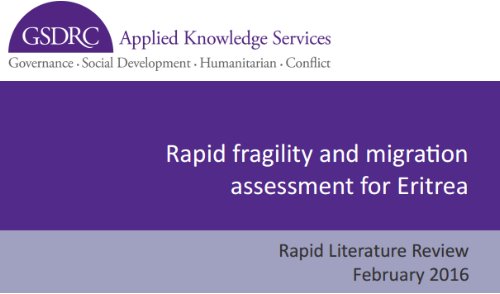Rapid fragility and migration assessment for Eritrea

February 2016
Eritreans have fled the country in large numbers since the 1960s as a result of war, poverty and a lack of freedom. The 30-year long Independence war produced a diaspora of over a million people, mostly based in Sudan, the Middle East, Europe and the US. Significant numbers displaced during this war returned after Independence in 1993 and throughout the remainder of the 1990s.
The border conflict between Eritrea and Ethiopia from 1998 to 2000 resulted in a further mass displacement of Eritreans to Sudan, and the expulsion from Ethiopia to Eritrea of approximately 75,000 Eritreans and Ethiopians of Eritrean descent. The cessation of these hostilities resulted in significant numbers of these newly displaced returning almost immediately to Eritrea’s western lowlands. The growing suppression of rights within Eritrea since 2001 has resulted in a year-on-year increase in the numbers of refugees in Sudan and in Ethiopia. A significant proportion of these individuals leaving Eritrea consider Europe their ultimate destination.
Eritrean asylum applicants are usually granted some form of protection, such as refugee status or subsidiary protection. Eurostat reports that 89 per cent of Eritrean asylum applicants were recognised in the European Union (EU)-28 in 2014 (EC, 2015d).
Migration trends from Eritrea are unlikely to change in the near and medium term. Migration from the country is driven primarily by indefinite national service; the suppression of political, economic and social rights; and the absence of private economic opportunities. Opposition parties are not permitted to operate within Eritrea, resulting in significant restrictions on freedom of speech. Discrimination amounting to persecution on the grounds of religion, ethnicity and political opinion constitute accepted reasons for Eritreans to claim asylum. There is no evidence of civil conflict within Eritrea, and the country is not noted as being vulnerable to the outbreak of violence or conflict.
Migrants leaving Eritrea are mostly men below the age of 40, although there is a notable percentage of women in this age category too. Reports suggest that, as a result of young people being drafted into national service from the final year of secondary school, a large number of Eritreans leaving are unaccompanied minors. Considering national and regional contexts, these trends are not likely to change in the near future.
The Eritrean government enforces strict emigration rules, which severely limit the possibilities for citizens to leave the country legally. Irregular emigration is harshly punished by detention, and death in some cases. Whereas asylum seekers are condemned as traitors, the Eritrean state attempts to maintain a tight economic and political relationship with members of the diaspora, such as through the 2 per cent development and recovery diaspora tax. Serious concerns about the treatment of returnees have generally prevented the deportation of Eritreans.
Remittances have been estimated to constitute around one third of national gross domestic product as well as a significant proportion of private household income. Although there is no evidence on how the government uses money from abroad, research suggests individuals often use remittances to subsidise livelihoods, subsistence costs and considerable financial outlays, such as the costs of education.
There is no clear evidence of state interventions to change the rules of national service, to reform the labour market or to increase the political and civil rights of Eritrean citizens. Unless these root causes of migration are addressed, asylum flows from Eritrea are not likely to decrease in the near future.
Continued international engagement with Eritrea, both financially and diplomatically, appears essential to address economic decline and regional isolation. According to some analysts, engagement on issues concerning external relations and economic and social stability may prove more successful if the EU does not simultaneously attempt to mediate on the border issue between Ethiopia and Eritrea.
Development assistance aimed at technical solutions – such as the energy and transport sectors – appears unlikely to significantly change migration patterns in the absence of sustained dialogue with the country’s leadership over reform to Eritrea’s political system, economic governance (specifically limitations on private enterprise) and national service requirements. Even if the main drivers of migration are addressed (mainly the rules of national service), predictions based on socioeconomic scenarios of the region do not envisage an inversion of migration trends.
Figures on Eritrean migrants remain limited in quantity and quality, not least because of the difficulties involved in registering the on-going flow of Eritreans leaving the country. Official reports often rely on unverifiable information collected from the Eritrean diaspora, migrants and refugees, and regional experts. Moreover, statistical data on the country and its economy is often outdated and unreliable. It should be noted that there has not been a national census in Eritrea since 1994, and current estimates of the population size range from 5.1 million in 2014 (World Bank, 2015b) to 6.5 million in 2015 (CIA, 2015). Very little research is conducted within the country, and data from international organisations within Eritrea is often collected by national staff through government-controlled channels. An attempt is made in this report to document the range of quantitative data on Eritrea when significant discrepancies have arisen.
Suggested citation
GSDRC (2016). Rapid fragility and migration assessment for Eritrea (Rapid Literature Review). Birmingham: GSDRC, University of Birmingham.


![[AIM] Asmarino Independent Media](/images/logo/ailogo.png)